The Battle of Plum Point Bend (Where?)
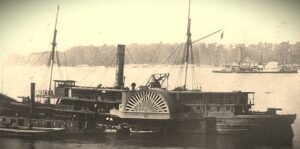
It wasn’t much of a battle in terms of forces engaged or casualties. If mentioned at all, it is passed over briefly in discussions of the more prominent First Battle of Memphis that quickly followed. Like many minor engagements, however, the affair at Plum Point Bend is an interesting microcosm—in this case of the naval war on heartland rivers.
By early 1862, campaigns for the spine of America were not going well for the South against a Northern waterborne juggernaut. Confederate defenses were falling like dominoes as the ironclads, gunboats, and transports of the Western Gunboat Flotilla, commanded by Flag Officer Andrew H. Foote, teamed up with the army to conquer in succession: Fort Henry on the Tennessee River (February 6), Fort Donelson on the Cumberland (February 11-16), and Mississippi Island No. 10 (February 28-April 8), while providing transport and heavy artillery support at the battle of Shiloh (April 6-7).
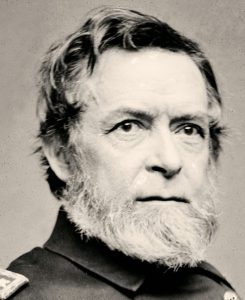
Memphis was next and citizens were worried. The flotilla proceeded downriver, arriving on April 13 at Plum Point Bend fifty miles above the city where Fort Pillow loomed high atop a bluff with numerous batteries guarding the river approach. Intelligence reports indicated the presence of from 9 to 13 Rebel gunboats.
The Union flotilla brought seven ironclads, one wooden gunboat, and sixteen mortar boats. When Maj. Gen. Henry Halleck concentrated all western armies for the advance on General P. G. T. Beauregard’s forces at Corinth, he left only two regiments, 1,500 troops, supporting Foote.
Without a major army commitment, the flag officer had little hope of taking the fort or city. He was prepared for an attack, but “our position here is a bad one.” The ironclads had taken a beating at Forts Henry and Donelson with minimal repairs and had been running hard since. Underpowered and cumbersome, the boats could hardly stem a powerful river current; in grappling with enemy boats, they might be disabled and drift down under the guns of the fort. Foote commenced a long-range mortar bombardment of Fort Pillow.[1]
In fact, only eight gunboat rams of the Confederate River Defense Fleet were present led by senior captain James E. Montgomery. This was a civilian volunteer organization of rivermen under army supervision. Montgomery, an experienced Mississippi River steamboat captain, obtained war department approval to create his own fleet of low-cost, steam-powered river rams capable of knocking big holes in and sinking Union warships.
His boats were a nondescript collection of passenger, cargo, and tow boats converted to rams with heavily reinforced bows, bulkheads packed with compressed cotton (which originated the moniker “cottonclads”) and one or two light guns as secondary weapons. These Rebel war boats were captained and crewed by contracted civilian rivermen with no command structure or doctrine. Captains would operate independently with little or no coordination.
As April flowed into May, Foote, suffering from a festering wound received at Fort Donelson, was relieved of command by Flag Officer Henry H. Davis. Each morning at 5 a.m., a steamer towed one mortar barge into position while a single ironclad stood by to defend it; the boats rotated daily for resupply.
Itching to take the offensive, Montgomery convened a council of war and issued written instructions to each captain: They were to move upriver at dawn the next morning in column and ram enemy ships as encountered. His intent was to surprise and overwhelm the single mortar barge at Plum Point, cast her loose to drift down into their hands while sinking or capturing the guardship.
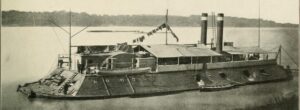
On May 10, 1862, the ironclad USS Cincinnati was on station near the point covering Mortar Boat Sixteen. Commander Roger Stembel kept her boiler steam up with the giant paddle wheel revolving slowly to steady her in the current. At 6:35 a.m., Rebel gunboats materialized around the bend led by the big side-wheel steamer General Bragg, distinguishable by her tall walking-beam engine and two masts. The rams General Sterling Price, Sumter, and General Van Dorn were next in line. Captain Montgomery rode his flagship, the small and swift Little Rebel. Brigadier General M. Jeff Thompson of the Missouri State Guard was aboard Bragg: “Every valve was opened to its uttermost and we rushed like the wind at the Iron Clads before us.”[2]
The remainder of the Union flotilla rested secured to the riverbanks four miles upstream. Lookouts aboard the ironclad USS Carondelet spotted heavy smoke coming upriver and altered her captain, Commander Henry Walke: “[We] at once prepared for action, and slipped her hawser to the ‘bare end.’” He set off immediately to the rescue followed closely by sister-ship Mound City. They charged downstream about a mile before other Union boats raised steam and got under way.
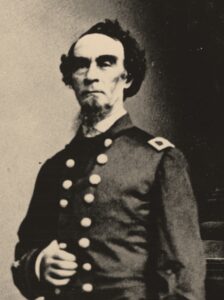
“The rams were advancing rapidly and we steered for the leading vessel…far in advance of the others, and apparently intent on striking the Cincinnati,” reported Walke. A raging melee erupted obscured by mist and smoke. Paddle wheels thrashed brown water; smoke billowed; big black muzzles boomed and erupted in flame, and Mini balls zinged—although to a modern observer it all would have unfolded in slow motion.
Carondelet and Mound City opened with their bow guns at three-quarters of a mile. Cincinnati scrambled to cast off mooring lines and head into the fight just as General Bragg struck her starboard quarter making, recalled Walke, “a great hole in the shell-room, through which the water poured with resistless force.”[3]
Cincinnati careened to port while Bragg‘s starboard wheelhouse and paddle wheel climbed right up the side of the sloping iron casemate. The two craft swung side-to-side; Cincinnati discharged volleys of musketry and a broadside at 10 feet, “making a terrible crashing in [the ram’s] timbers.” Return musket fire seriously wounded Commander Stembel, mortally wounded another officer, and a sailor in the leg. General Bragg backed away and drifted downstream disabled and under fire from Carondelet.[4]
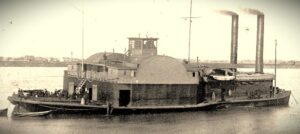
Pushed around by the first blow, Cincinnati quickly absorbed two more, first to starboard from General Sterling Price, carrying away the ironclad’s rudder, sternpost, and a large piece of her stern, and then right aft by Sumter, striking so hard that the ironclad’s bows were pushed under water, her boiler fires extinguished, magazines and shell rooms flooded.
Cincinnati rapidly took on water as they relit fires and staggered toward shallows where the deeper-draft Rebel gunboats could not follow. Meanwhile, the mortar barge crew jacked the massive gun to minimum elevation, reduced the powder charge, and fired multiple rounds with fuses set to burst directly over enemy boats.
General Van Dorn surged up firing muskets and point-blank shots from her 32-pounder in an unsuccessful attempt to silence the mortar boat, then steered for Mound City, which was pouring broadsides into General Sterling Price and Sumter. Van Dorn struck Mound City a glancing blow, “making a hole 4 feet deep in her starboard forward quarter, evidenced by splinters left on the [ram’s] iron bow,” wrote Montgomery, and then ran aground where for several minutes she sustained a terrific cannonade before backing off.[5]

Surrounded by enemies, Carondelet performed a cumbersome pirouette. Walke: “We fired our bow-guns into the General [Sterling] Price, and she backed off, disabled also.” They passed Cincinnati apparently sinking, and “rounding to,” swiveled back upstream to avoid a shoal. Carondelet fired in succession bow and starboard broadside into the retreating General Bragg and into other advancing rams while bringing her port broadside guns to bear on Sumter and Sterling Price.
Walke ordered the port rifled fifty-pound Dahlgren gun to be leveled at Sumter. “The shot struck the vessel just forward of her wheel-house, and the steam instantly poured out from her ports and parts of her casemates, and we saw her men running out of them and falling or lying down on her deck.”[6]
Finally, with his stern guns, he traded additional shots with the last rams in the Rebel line, General Thompson, General Beauregard, and Colonel Lovell as they struggled up to engage. “It is worthy of note,” wrote General Thompson, “that the gunners on the open forecastle and sterns [of the rams] served their guns steadily amid a shower of missiles without one casualty.” The flagship Little Rebel “ran about amid the storm as heedlessly as if charmed.”[7]
Ironclads Benton, Pittsburgh, and St. Louis approached the fray amidst smoke so dense Walke could hardly distinguish friend or foe: “The upper deck of the Carondelet was swept with grape-shot and fragments of broken shell.” Sharpshooters on the exposed casemate roof hunkered down behind a deckhouse to avoid projectiles from up and down river. Pittsburgh’s fire from above put them “more in dread of her shot than those of the enemy, but providentially there were no killed or wounded.” Carondelet expended fifty-seven 64-pounder, 32-pounder and rifled solid shot, and three rifled shells.[8]
As the enemy’s massed firepower came to bear, Captain Montgomery called a withdrawal to Fort Pillow, which, as he reported to Beauregard, “was accomplished with a coolness that deserves the highest commendation…. While exposed at close quarters to a most terrific fire for thirty minutes, our boats, although struck repeatedly, sustained no serious injury.” Casualties were two killed and one broken arm. “They will never penetrate farther down the Mississippi.” General Thompson: “We fell back, cheering and shouting.” [9]
“This engagement was sharp, but not decisive,” concluded Commander Walke. One hour and ten minutes elapsed from first shot to last. Flag Officer Davis regretted not capturing the damaged Rebel rams, but they had no means of towing them upriver.[10]
Mound City “had her bow pretty much wrenched off,” reported Lt. Phelps of Benton, “and was run onto the shoal opposite where we had been lying. The Cincinnati ran to the bank below where we laid…and sunk in 11 feet water.” Both heavily damaged vessels were pumped out, sent up to the naval base at Cairo, Illinois, repaired, and back in service by the end of the month.[11]
The siege of Corinth ended when outnumbered Confederates withdrew on May 29 followed by the evacuation of Fort Pillow on June 4. The First Battle of Memphis exploded on June 6 (Read what happened there in previous posts here and here). The city capitulated; the Mississippi was open to Vicksburg, but it would take another year of army and navy cooperation to conquer that mighty bastion.
[1] Official Records of the Union and Confederate Navies in the War of the Rebellion, 29 vols. (Washington, DC, 1894-1921), Series 1, vol. 23, page 12. Hereafter cited as ORN. All references are to series 1.
[2] Chatelain, Neil P., Defending the Arteries of Rebellion: Confederate Naval Operations in the Mississippi River Valley, 1861–1865 (California: Savas Beatie, 2020), 123.
[3] Walke, Henry, Operations of the Western Flotilla (Archive Arts American Civil War Book 2), Kindle Edition, Loc 517-528 of 1364.
[4] ORN 23, 18.
[5] Ibid., 56.
[6] Walke, Operations, Loc 528, 535.
[7] ORN 23, 55.
[8] Walke, Operations, Loc 539.
[9] ORN 23, 56-57.
[10] Walke, Operations, Loc 546.
[11] ORN 23, 19.
“When one is in muck up to their waist, being attacked by alligators, it may be difficult to remember that the mission is to ‘Drain the swamp.’”
In early 1862 the Mission of Union forces in the Western Theatre was “to open the Mississippi River to Northern commerce,” allowing goods from Cincinnati and Pittsburgh to flow unhindered to the Gulf of Mexico and away to markets in Europe and South America. Major General Henry Halleck was put in charge of opening the Mississippi River from the north… but a Rebel fortification on a high bluff, Fort Columbus – termed “Gibraltar of the West” – with stout barrier chain protected by torpedoes and over 100 artillery pieces, stood in the way. Too strong for direct assault, Major General Halleck authorized actions to the rear of Fort Columbus, against Forts Henry and Donelson and “turned” Fort Columbus: that “Gibraltar” was evacuated end of February 1862, and half its garrison joined Beauregard’s army at Corinth; and the other half became the defenders at Island No.10.
Flag-Officer Foote and Brigadier General Pope spent a month building a canal, conducting raids, floating a balloon and pounding the Rebels with 215-pound mortar shells… and two of Foote’s gunboats ran the gauntlet and turned up in the rear of Island No.10, forcing the entire garrison to surrender. And Foote and Pope continued south, soon arriving in vicinity of Fort Pillow (Rebel Brigadier General John Villepique.) On 13 April a half dozen Rebel gunboats steamed north and attempted to drive away Foote’s gunboats; the Rebels were forced to retire to the protection of Fort Pillow’s guns. And after Pope determined that “attacking Fort Pillow over land, from the rear was not feasible,” plans were put in place to build a canal through Arkansas, bypassing Fort Pillow, allowing Foote’s fleet to avoid Fort Pillow entirely. But on 17 April Pope’s force of 20,000 men was mostly withdrawn, ordered to Pittsburg Landing to join Halleck’s Crawl to Corinth; and the 1500 men left behind were insufficient to accomplish the canal project. A desultory long range bombardment via 13-inch mortars was initiated from vicinity of Plum Point Bend… and this practice was maintained, even after Captain Davis arrived in theatre.
Meanwhile, Flag-Officer Foote was informed by telegram on 27 April “Farragut’s force has passed the forts below New Orleans.” Opening the Mississippi River from the south was at last underway.
Andrew Hull Foote, wounded at Fort Donelson and suffering lingering poor health and exhaustion, was relieved “temporarily” by Captain Charles Henry Davis on 9 May 1862.
OR(Navy) Ser.1 Vol.23 pages 12-14 and “Life of Andrew Hull Foote” (1874) by James M. Hoppin pp.292- 312.
His name was Joseph Ed Montgomery, not Jame E. Montgomery.